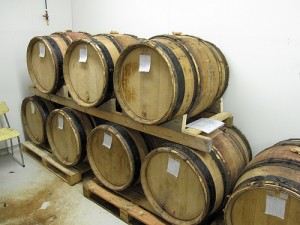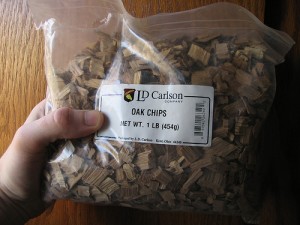About a year and a half ago, I reviewed an article that examined the effect of the application of an oak extract to Verdejo grapes on the potential oak flavor of the finished wine, in lieu of oak barrel fermentation or ageing, or the use of oak chips in stainless steel tanks (to read that full article, click here). The main take-away from that article was that oak extract application on Verdejo grapes does, in fact, produce a finished wine that mimics the flavors and aromas of a wine that has been aged in oak barrels.
I had one reader comment: “who would want oak on Verdejo anyway?”; which is certainly a valid question! Who knows! Maybe Verdejo was what the authors had at their disposal at the time. Anyway, those same authors about a year later published a very similar experiment, however this time, focusing on a grape that is almost exclusively oaked: Petit Verdot.
Studies (and experience) have shown that grapes exposed to smoke from wild fires result in wines with a burnt or smoky flavoring. Taking this concept further, we’ve seen in the Verdejo study mentioned previously and other studies that certain compounds sprayed onto the grapes during the growing season (such as oak extract) result in wines with similar aromatic characteristics. In addition to the grapes themselves, alcoholic fermentation, malolactic fermentation, and the aging process all have influence on the aromatic profile of the finished wine.In regards to the aging process, oak aging in particular has a significant influence on the aromatic development of the wine (compared to the stainless steel alternative). Sometimes aging in oak barrels can be problematic for some vineyards, due to the relatively high cost of a single barrel and the long periods of aging time required to produce a wine with certain aromatic characteristics. Smaller wineries may not have enough money and/or time to be able to age their wines in oak barrels for these very reasons.
One alternative approach is to use oak chips in stainless steel tanks, though this practice is still thought of as poor-quality and less desirable (though in reality, most people can’t tell the difference). Another alternative, which is the focus for today’s paper, is to instead apply oak extracts directly to the grapevine, which could result in wines retaining the characteristics of these extracts, thus eliminating the need to age the wines in relatively expensive oak barrels. This
alternative is still relatively novel, and is still in a more experimental phase than a widely practiced phase.
Methods
The oak extract used was food quality French toasted aqueous oak extract from Protea France S.A.S.
The grapevines used were the Petit Verdot variety grown in La Mancha region of Spain (southeast Spain).
There were 4 different treatments used in this experiment: 1) a 25% dilution of the oak extract applied once on the 7th day after veraison (when the grapes start changing color); 2) a 25% dilution applied 4 times; on the 4th, 7th, 10th, and 13th days after veraison; 3) an undiluted (100% concentrated) oak extract solution applied once on the 7th day after veraison; and 4) an aqueous solution of eugenol and guaiacol standards applied once on the 7th day after veraison. An untreated control was also used for this experiment.
Treatments were applied to 10 plants in the same row, with 5 plants left untreated between treatments in order to avoid contamination. 250mL of each treatment was sprayed on the leaves of each plant at around 7am and when the temperature was below 20oC.
After grapes were harvested at maturation, grape yield was calculated. Winemaking took place in a multitube fermenter, which has been shown to reproduce actual cellar and winemaking conditions. Wines underwent both alcoholic and malolactic fermentation, and were done in duplicate. After malolactic fermentation was complete, wines were stored bottles at 14oC for 8 months. Samples were taken at each fermentation step, as well as after the 8 months of storage time.
The following enological parameters were measured for each sample: yeast assimilable nitrogen (YAN), oBaumé, reducing sugars, alcohol degree, titratable acidity, volatile acidity, pH, malic acid, and lactic acid. All parameters were measured in triplicate. Volatile compounds were also measured and analyzed.
Results
Grapes
- YAN, oBaumé, probable alcohol, pH, titratable acidity, and the ratio of oBaumé to titratable acidity of grapes from the oak extract treatments were not significantly different than the control grapes.
- YAN levels were higher and oBaumé, pH, and probably alcohol levels were lower in grapes treated with eugenol and guaiacol compared with the controls.
- No oak lactones or 6-methoxyeugenol were found in any of the grape samples.
- Furfural levels were higher in oak extract treated grapes, with the 25% dilution extract treated four times throughout veraison having higher levels than the 25% dilution extra treated only once during veraison.
- The lowest levels of acetovanillone, methyl vanillate, and guaiacol were found in the undiluted (100%) oak extract treatment.
- The 25% dilution extract treated four times throughout veraison and the undiluted (100%) oak extract had lower levels of 4-vinylguaiacol and 4-ethylphenol compared with the control.
- Syringol was lower in oak extract treated grapes.
- The eugenol and guaiacol treatment grapes showed higher levels of eugenol and guaiacol (surprise surprise), as well as furfural, 4-vinylguaiacol, 4-ethylguaiacol, and syringol.
- Discriminate analysis could not distinguish between the oak extract treated grapes and the control grapes, but could distinguish a difference in regards to the eugenol and guaiacol treated grapes.
Wine
- Eugenol and guaiacol treatment resulted in the wine with the lowest alcohol level.
- After alcoholic fermentation, titratable acidity was higher in all treatments compared to the control, however, after 8 months, titratable acidity was the same for all wines.
- After 8 months, eugenol and guaiacol treatment wines had a lower pH than the control.
- After alcoholic fermentation, volatile acidity was highest for control wines and lowest for eugenol and guaiacol treatment wines.
- Malolactic fermentation progressed equally in all wines.
- There were no oak lactones found in the control wines.
- Oak lactones were found to be present in all oak extract treatment wines.
- After alcoholic fermentation, the wine with the highest levels of oak lactones was the 25% dilution that was applied 4 times throughout veraison.
- After 8 months, these levels decreased in these wines as well as the wines from the 25% dilution that was only applied once. These levels increased for undiluted (100%) oak extract treatment wines.
- Concentrations of oak lactones never reached sensory perception thresholds in any of the wines.
- Furfural and 5-methylfurfural levels were higher in oak extract treatment wines compared with the control wines.
- Over time, these levels decreased in all wines.
- Levels of both these compounds were below their sensory thresholds in all wines.
- After alcoholic fermentation, eugenol levels were higher in oak extract treatment wines compared with the control wines.
- After 8 months, eugenol levels were actually higher in control wines than oak extract treatment wines.
- 6-methoxyeugenol levels were higher in oak extract treatment wines than control wines, with the highest levels in the undiluted (100%) oak extract treatment wine.
- These levels increased during malolactic fermentation in all wines.
- After alcoholic fermentation, guaiacol levels were higher in all treatment wines compared with the control wines.
- These levels increased in the treatment wines after malolactic fermentation.
- After 8 months of storage, guaiacol levels were 3x higher in treatment wines compared with the control wines.
- Guaiacol levels were higher than their sensory threshold levels in all wines.
- 4-ethylguaiacol levels were higher in oak extract treatment wines compared with the control wines.
- Levels were found to be below sensory threshold in all wines.
- Syringol levels were higher in oak extract treatment wines than in control wines (recall: this trend was the opposite in regards to the levels in the grapes).
- Levels were found to be below sensory threshold in all wines.
- Vanillin, vanillin derivatives, acetovanillone, and methyl vanillate were all higher in oak extract treatment wines compared with the control wines.
Conclusions
According to the results of this study, applying oak extract on Petit Verdot grapes during veraison resulted in changes in the aromatic profile of the finished wines. Finished wines appeared to have many of the volatile compounds frequently found in wines that are fermented in aged in oak barrels. It’s interesting to note that nearly all of the oak volatile compounds were not actually present in the grapes themselves, but were present after the fermentation and storage processes. What is happening here is likely that the oak volatiles are present in grapes as non-volatile precursors, which undergo changes during the fermentation and storage processes that result in the formation of their volatile counterparts in the wine.
In addition to the oak extract treatments, I would have liked to have seen two more treatments: 1) fermentation in oak barrels and 2) fermentation using oak chips. It would have been interesting to compare the oak volatile compounds from the oak extract treatment wines directly to those from oak barrel fermented or oak chip fermented wines. How do the levels of the oak volatile compounds in these oak extract treatment wines directly compare with wines fermented in oak barrels or using oak chips? Sure, the levels are increased with respect to the controls, but is it enough to produce a wine that would taste the same (or similar) to a wine produced in more traditional ways?
The above being said, it would have been interesting to see a sensory analysis of these wines, in addition to the chemical analysis that they performed. How did the wines actually taste? How do they actually taste compared to wines made in a more traditional manner?
The results of this study provide some evidence that the use of oak extracts on grapevines during the veraison process yields aromatic profiles similar to that of wines fermented in oak barrels, and thereby could be a good alternative to the more expensive and time consuming oak barrel fermentation methods. However, before I can say that previous statement with complete certainty, I’d like to see a few more treatment comparisons.
How about you all? What do you think of this study? Please feel free to comment!
Source: Martínez-Gil, A.M., Garde-Cerdán, T., Zalacain, A., Pardo-García, A., and Rosario Salinas, M. 2012. Applications of an oak extract on Petit Verdot grapevines. Influence on grape and wine volatile compounds. Food Chemistry 132: 1836-1845.

![By Eric 先魁 Hwang [CC-BY-2.0 (http://creativecommons.org/licenses/by/2.0)], via Wikimedia Commons](http://www.academicwino.com/wp-content/uploads/2013/02/petit-verdot-The-Academic-Wino-300x198.jpg)

